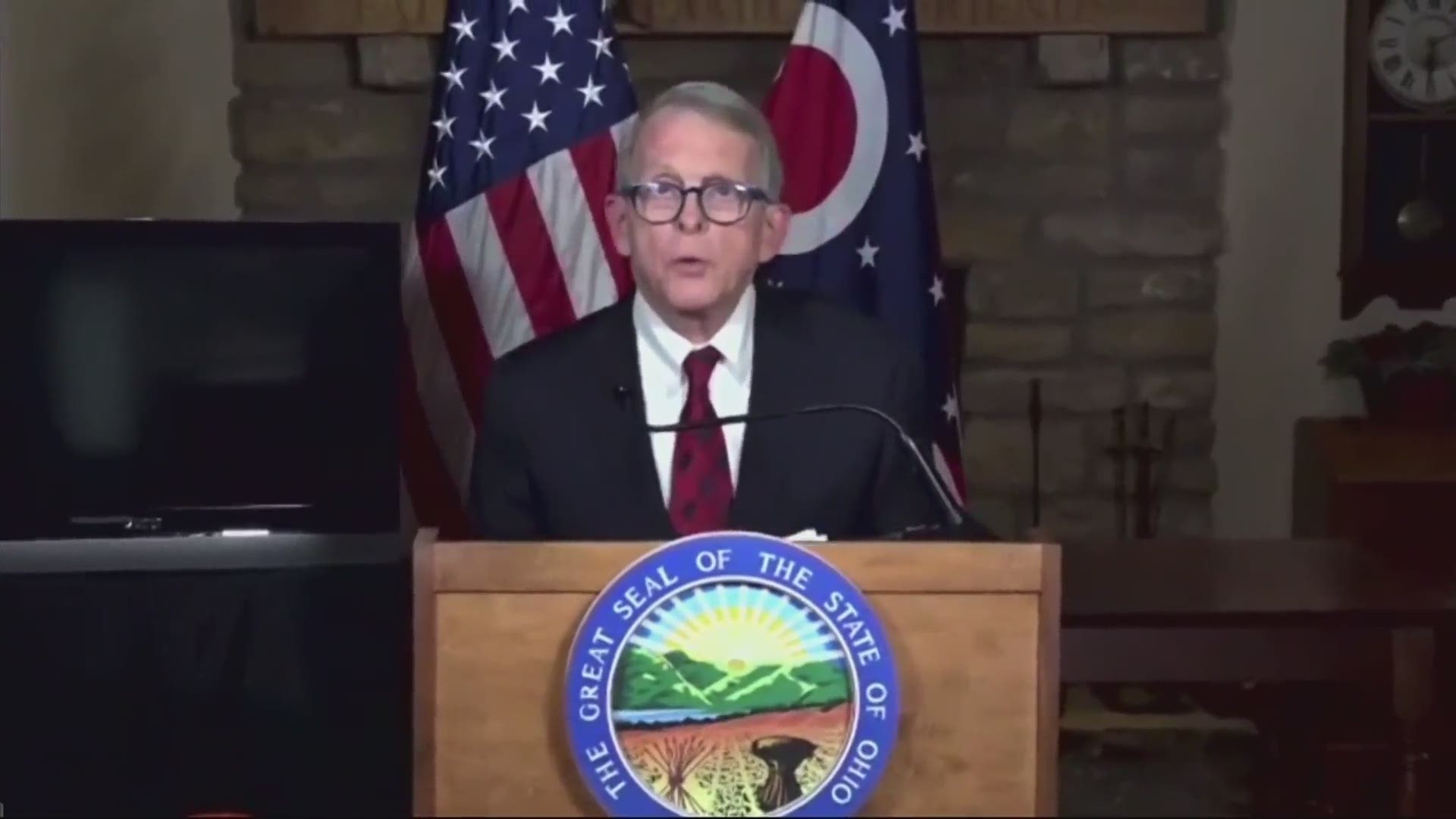COLUMBUS, Ohio — Ohio Gov. Mike DeWine held a surprise press conference Friday evening, addressing concerns that several school districts who signed on to the promise to get back to the classroom by March 1 are going back on the deal after receiving the vaccine.
"We have learned that there are a handful of schools that have indicated that they will break that promise, that they will break that commitment; not just a commitment to me, but really a commitment to the children of that district. This is simply not acceptable," DeWine said.
Every public school district in the state besides one has signed onto the state's agreement, requiring schools to commit to returning to some form of in-person learning in order to gain vaccinations for its staff.
The governor specifically called out three districts on the state for going back on that promise: Cincinnati Public Schools, Akron Public Schools and Cleveland Public schools, the latter of which was still in the middle of vaccine distribution as of Friday.
Cincinnati Public Schools was notably the first district to receive the vaccine and did so before educators technically qualified. DeWine explained Friday that the district's superintendent had requested her schools receive the vaccine early in an effort to get kids back in the classroom as soon as possible.
Vaccination has long been complete within the district, but DeWine claimed Friday that one of CPS's high schools, Walnut Hills, is expected to stay remote the rest of the academic year.
A reporter noted that the district made that decision after they realized that proper distancing within the building, but DeWine said that issue should have been raised much sooner, when the letter of intent had been signed.
Akron City Schools has also completed vaccination of its staff, but district leaders have since reported that they do not plan to return to in-person learning until March 15 - two weeks after the state's deadline.
Cleveland City Schools is currently working to vaccinate its staff, although DeWine said he had heard "different reports" over whether or not Cleveland would go back by March 1.
The governor detailed a discussion he had with the district's CEO Eric S. Gordon, saying he asked if the state should "stop the vaccination." DeWine said that at the end of that call, Gordon promised to do everything in his power to get kids back by that March 1 date.
DeWine explained that the thought of halting vaccination within the district was not punitive. He said that those shots were allocated to those schools with the understanding that it would be getting students back to the classroom and if they weren't being used for that reason, that the doses should then go to more vulnerable Ohioans.
No other districts at this point have made clear plans to waver on the commitment to return, and DeWine said he was "very happy" with the number of schools that have gone back to in-person education.
In Dec., 45% of Ohio students were fully remote. As of Tuesday, DeWine said that number had lowered to less than 15%.
"We've already accomplished by this plan a great deal. We've got a lot of kids back in school," he said.
DeWine held two other press conferences the week of Feb. 8. Here is a breakdown of what was discussed.
THURSDAY
Ohio Gov. Mike DeWine addressed the state Thursday with new information on his team's pandemic response plan.
During his afternoon presser, the governor lifted the state's curfew, addressed underreported data from the Ohio Department Health and explained what comes next for those left to be vaccinated in Phase 1B.
Here is a breakdown of what was discussed.
CUREW CANCELED
Dewine confirmed that the state's coronavirus curfew - which expired Thursday at noon - would not be extended, meaning there is no longer a curfew in Ohio.
The move comes as hospitalizations continue on a downward trend, with the total number of COVID-19 positive patients in Ohio hospitals below 2,500 for the past 10 days, three days more than the state's requirement.
However, DeWine made clear that the curfew could always be reinstituted should statewide hospitalizations spike again.
COVID-19 DATA
On Thursday, the Ohio Department of Health reported:
- 2,806 new cases of coronavirus compared to the 21-day average of 3,892
- 721 deaths reported compared to the 21-day average of 98*
- 189 new hospitalizations compared to the 21-day average of 188
- 19 new ICU admissions compared to the 21-day average of 21

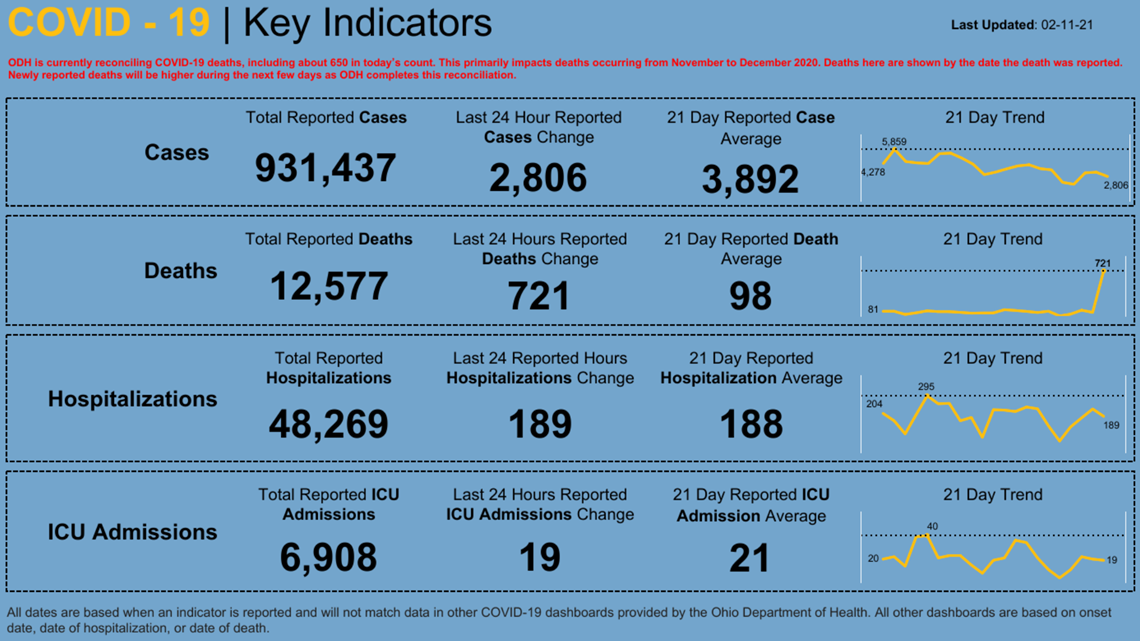
UNDERREPORTED DEATHS
On Wednesday, the Ohio Department of Health announced that as many as 4,000 deaths in the state may have gone underreported. Those deaths will be reflected in the daily reports over the next few days before returning to normal.
For Thursday, approximately 650 of the reported deaths were from the ongoing reconciliation. The department expects this process to be resolved by next week.
The error sheds new light on the impact the virus has had on the state, however, as the 4,000 previously unreported deaths would bring the state's total to a number closer to 16,000 rather than the 12,000 previously reported - a 33% jump.
VACCINE DISTRIBUTION
The state is expected to receive a slight increase in the number of first vaccine doses for Ohioans next week.
This week, the state received 214,525 first doses; next week, that number is expected to jump to 223,025.
In addition to the increase in doses, the vaccine may become more accessible in Ohio. The shot will soon be coming to more than 160 Rite Aid locations and expand to all 194 Ohio Kroger stores.
WHO IS LEFT IN PHASE 1B?
One of DeWine's three goals in the state's vaccination process is to reduce the number of lives lost to COVID-19.
As part of this effort, he has instructed health care providers to prioritize those with developmental disabilities and severe medical conditions for vaccination.
The state estimates that as of Thursday, 12,000 people in that category have been vaccinated.
Next week, Ohioans with certain conditions they were born with or those who were diagnosed in childhood with conditions that carried into adulthood will begin to receive their COVID-19 vaccine.
DeWine said that individuals with these conditions face a significantly higher risk for adverse COVID-19 outcomes.
Here's a look at who is eligible under these criteria.

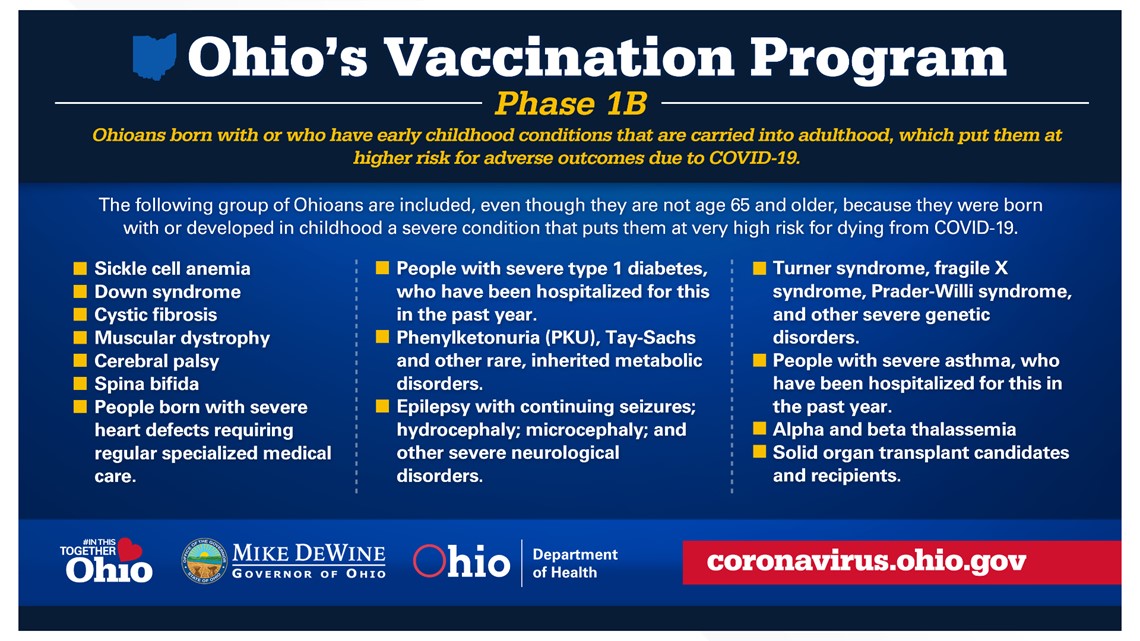
LONG-TERM CARE FACILITIES
Over 50% of Ohio's COVID-19 deaths have in the state's nursing homes, a data point that led DeWine to put these Ohioans at the front of the line for vaccinations.
In a two-month period, the number of COVID-19 cases dropped dramatically in nursing homes. For perspective, during the week of Nov. 29, 2020, there were 2,695 new cases in long-term care facilities. During the week of Jan. 17, there were just 612 new cases - a 77% drop.
In order to reach out to even more vulnerable seniors in the state, the Ohio Department of Aging has teamed up with the Ohio National Guard to distribute vaccines in affordable senior housing locations.
On Wednesday, 300 people were vaccinated in Toledo through the state's program.
COMPLETE PRESS CONFERENCE
TUESDAY
SCHOOLS
DeWine reiterated Tuesday his goal of getting all students back to in-person learning by March 1. Teachers and school staff were included in Phase 1B of the state's vaccination rollout plan for this very reason, he said.
In one week, 566 schools in the state have had teachers and staff vaccinated. At the end of this week, DeWine said that number will jump to 1,300.
The governor said that schools in the state are shifting, with more and more making the return to in-person learning.
"We are already really seeing a change; we are seeing a movement from remote learning to being back in the classroom," DeWine said.
In Dec., 45% of Ohio students were fully remote. On Tuesday, DeWine said that number had lowered to less than 15%.
FALL 2020 ENROLLMENT AND ASSESSMENT DATA
Ohio's Superintendent of Public Instruction, Paolo DeMaria, joined in on Tuesday's conference with an update on fall 2020 enrollment and assessment data.
Data showed that at the beginning of the school year, there was a decrease in enrollment by about 3%, with high concentration being in pre-school and kindergarten age groups.
Student performance scores were also lower. In kindergarten, 8% more students were found to be "not on track." For the state's third-graders, about 8% less students scored "proficient" or better. Almost all districts, 87%, had a decrease in this metric between 2019 and 2020.
The study also looked at the impact of the different modes of instructional delivery during the pandemic.
In fully remote districts, those third-grade proficiency rates decreased even more substantially, by about 12% compared to 8% shown by those under a five-day in-person learning model.
However, DeMaria cautioned everyone not to extrapolate too much from the average, as every student is different, living under different circumstances and with different needs.
HOW TO HELP STUDENTS GET CAUGHT UP
Each school district in the state has been asked to formulate a specific plan aimed at the individual needs of their students. DeWine also encouraged parents to reach out to their schools to explain the specific needs of their child, and what they think could help, calling it a "public conversation."
DeWine said that some schools may decide that longer school days, summer school or tutoring to help catch up, however, the specific plan is up to the individual district. The governor has asked public school leaders to make their plans public by April 1.
How will this be paid for? DeWine said that members of the Ohio General Assembly signed a bill, providing $2 million to Ohio schools. Schools can use this funding for many purposes over the next two years. However, they are encouraged to use it toward closing the education gap caused by the pandemic.
"The future of our state depends on how we help our children today. We simply cannot fail these children," DeWine said. "Each child in Ohio, each child deserves the opportunity to live up to his or her God-given potential."
In the state's executive budget, DeWine said his team will be expanding their investment in student wellness and success programs and the wrap-around services they provide to $1.1 billion.
"With this flexible funding, individual schools make decisions about what their students need most," DeWine said.
So far, more than one in four of the initiatives have been focused on mental health services, while almost one in seven initiatives have been focused on physical health services.
OHIO RENT ASSISTANCE
DeWine said Tuesday his team has worked with the General Assembly, requesting that the Controlling Board approve $100 million in federal funding to help low-income Ohioans who do not own their own home pay their rent, water, sewer, wastewater, electric, gas, oil and/or trash removal bills.
The Ohio Development Services Agency is distributing the funding among Ohio's 47 Community Action Agencies.
Eligible Ohioans may contact their local Community Action Agency for help. To find a list, click here.
In order to be eligible, households must:
- Be at or below 80% of their county's Area Median Income (varies by county and size of household)
- Have experienced a financial hardship due to COVID-19
- Demonstrate a risk of experiencing homelessness due to housing instability

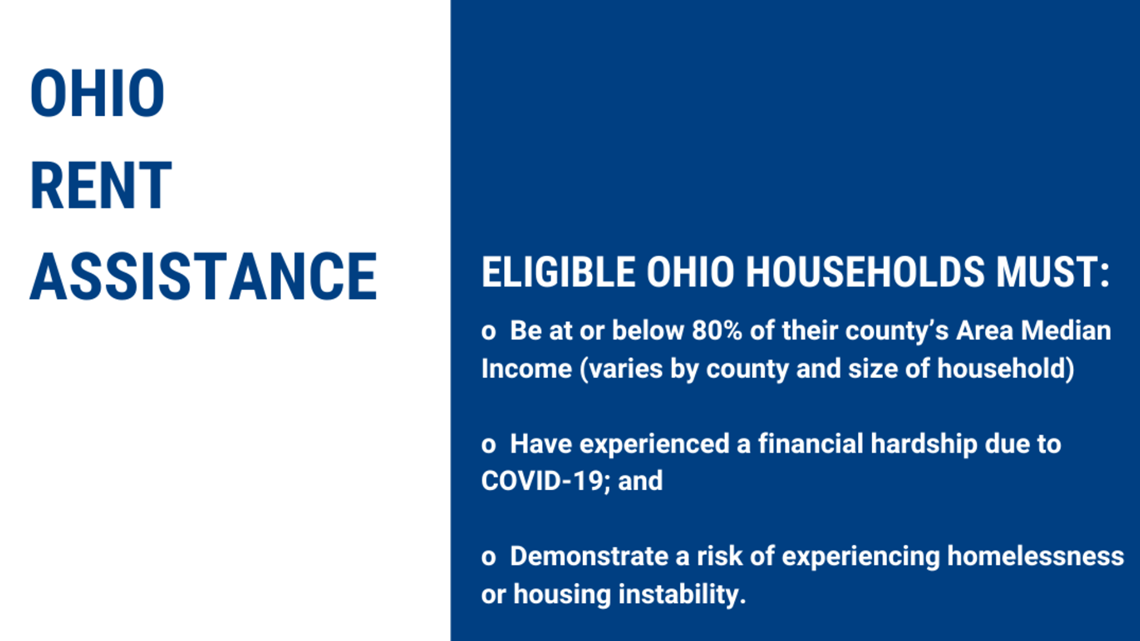
DeWine said assistance can go toward outstanding balances dating back to March 13, 2020, assistance for future rent or utility payments once back bills have been made current, and future rent and utility assistance for three months at a time.
NURSING HOMES
DeWine said 50% of the state's coronavirus deaths have come from Ohio nursing homes, which is why this group was priortized for vaccine distribution.
Now, what comes next? When these vaccinations are done, nursing homes will still be taking in new residents and may be taking on new staff - these people will need to be vaccinated.
DeWine said details are on the way next week on the state's plan to make sure these facilities have continued access to the coronavirus vaccine.
For this week, administrators in Ohio nursing homes and assisted living facilities have been asked to contact their current pharamacy provider and ask if they are a COVID-19 vaccine provider, and if not, if they intend to become one.
KEY INDICATORS
- 3,207 new cases of COVID-19 compared to the 21-day average of 4,252
- 98 new coronavirus-related deaths compared to the 21-day average of 69
- 181 new hospitalizations compared to the 21-day average of 202
- 22 new ICU admissions compared to the 21-day average of 23


CURRENT COVID-19 PATIENTS IN OHIO HOSPITALS
The number of COVID-19 postive patients in Ohio hospitals continues to drop. On Tuesday, there were 1,974.
If the current trend continues, and the number of COVID-19 patients in Ohio hospitals stays below 2,500, the statewide curfew could be dropped as early as Thursday.

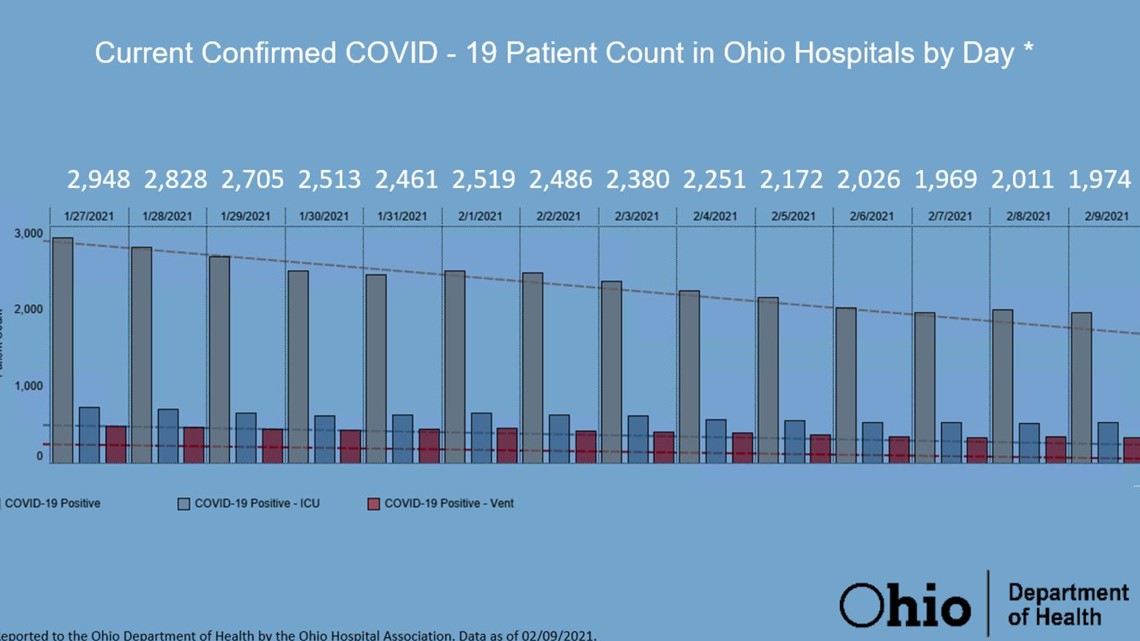
FULL PRESS CONFERENCE
You can watch the full Feb. 9 coronavirus press conference in the player below.

